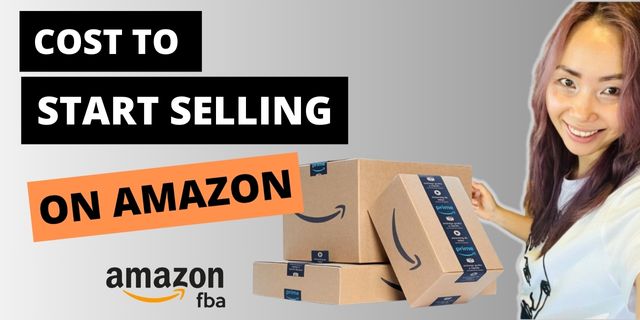Amazon FBA Definitive Guide, Everything You Need To Know
Click in the question to find the answer.
- What is FBA?
- What is FBM?
- What Is Selling Private Label Products on Amazon?
- What Is Wholesale on Amazon?
- Wha Is Dropshipping on Amazon?
- What Is Arbitrage on Amazon?
- Top 10 Unbeatable Benefits of Amazon FBA
- How Much Money You Can Make by Selling on Amazon?
- How Does Amazon FBA Work?
- How Much Does Amazon FBA Cost?
- How Much Does It Cost To Start Selling on Amazon in 2024?
What is Amazon FBA?
FBA, which stands for “Fulfillment by Amazon,” is a service where Amazon handles the shipment of products to customers for online sellers. Amazon takes care of the storage, packing, shipping, customer service, and returns of products. Sellers can use FBA not only for sales made on Amazon’s platform but also for orders from other online channels, such as a Shopify store. This service is particularly advantageous for sellers looking to leverage Amazon’s extensive logistics network and customer service capabilities.
What is FBM?
FBM, which stands for “Fulfillment by Merchant”, is a business model where you sell on Amazon but you are responsible for managing storage, shipping, packing, customer service, and handling returns independently or via a third-party logistics provider. This model offers sellers more control over their inventory and customer interactions but also requires them to manage the logistics that Amazon would otherwise handle under FBA.
What Are the Most Popular Ways to Sell on Amazon?
Private Label
You sell your own branded product on Amazon. You can make the product yourself or source from a manufacturer. You create and own a trademark/brand name for the product.
Wholesale
You buy products in bulk from other popular brands and resell them on Amazon at a markup. Wholesale allows you to leverage established brands’ products without needing to create and market your own brand.
Dropshipping
You sell products on Amazon without actually holding any inventory beforehand. Instead, when somebody buys the product on Amazon, you order it from the supplier, who then ships it directly to the customer. That manufacturer will ship the product to the customer. Basically, you act as a middleman.
Arbitrage
You buy products from retail stores or online stores at a discounted price and resell those products on Amazon at a higher price. It’s similar to wholesale in a sense that you resell other brands’ product on Amazon. However, the key difference lies in the sourcing: arbitrage often involves buying retail items, while wholesale involves purchasing in bulk directly from manufacturers or brands for resale on Amazon.
Top 10 Unbeatable Advantages of Amazon FBA
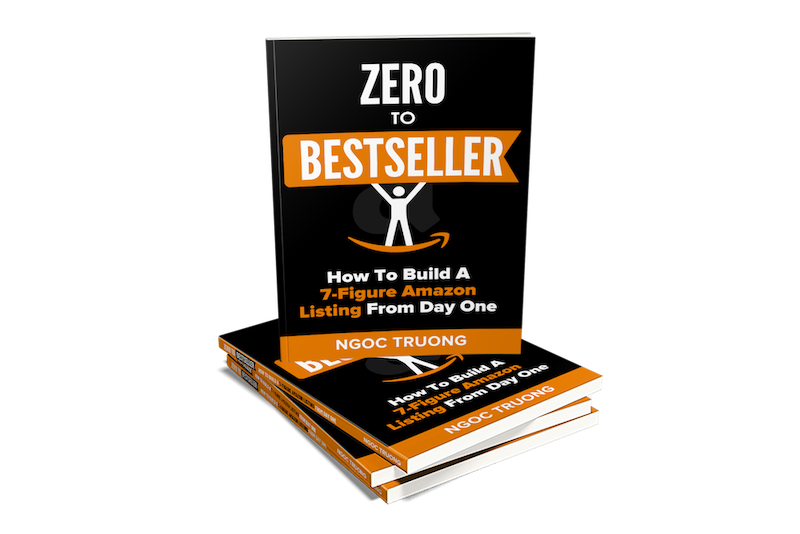
Learn how to build a bestseller Amazon listing right from the ground up.
1. Streamlined Fulfillment Process
Utilizing Amazon FBA for selling means you don’t have to worry about the logistics of storage, packing, shipping, customer service, and returns. Amazon fully manages this fulfillment chain.
2. Equal Fulfillment Efficiency Between Small and Large Businesses
Using FBA is not only advantageous for big businesses but also small ones. FBA offers optimal shipping time and cost. And small businesses can equally enjoy this benefit with big ones.
Amazon has the widest network of warehouses and the most optimised fulfilment system. One of the main reasons why Amazon became the largest ecommerce platform is because of its optimised and heavily invested fulfilment network. Thanks to which, the shipping cost and shipping time are highly competitive. Customers can receive their items even within the same day. Amazon has 150 fulfilment centres in the US only, and over 450 fulfilment centres worldwide, and the numbers don’t stop growing. This is the core advantage of Amazon as a pioneer in ecommerce fulfilment space.
Therefore, utilizing FBA is advantageous not only for large businesses but also for small ones that cannot secure competitive shipping rates independently. The FBA fulfillment fee is determined by the size and weight of the item, and it remains consistent regardless of the monthly sales volume. Unlike other fulfillment services that may vary their rates based on the quantity of orders, FBA provides small businesses with the same benefits in terms of shipping costs and delivery times as larger companies enjoy.
Not only am I a seller in multiple marketplaces, including the US, but I am also a consumer on Amazon. I can see that Amazon offers the most efficient deliveries. For example, in Australia, most online retailers don’t deliver on weekends, but Amazon Australia does. This is again the reason why the best becomes the best.
Not to mention only 9 AUD Prime membership where customers can have free deliveries for the entire month. Whereas, most other online retailers in Australia don’t offer free delivery or impose a minimum order value for free standard delivery.
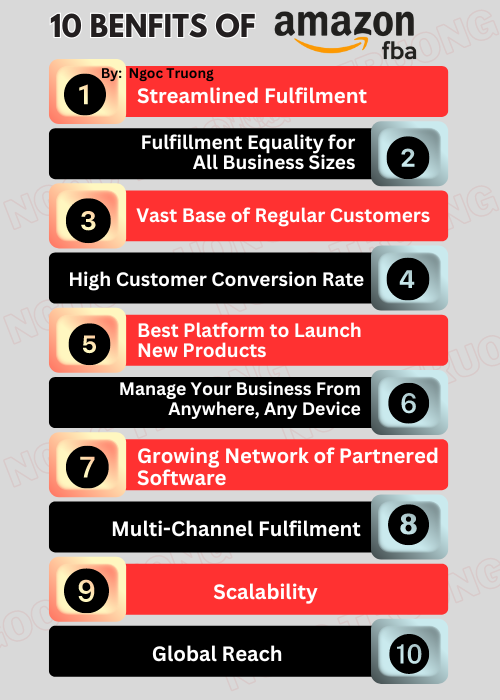
3. Vast Base of Regular Customers
Another reason why Amazon has triumphed in the e-commerce space is that it began as a customer-centric platform. Everything is about and for customers. Amazon has cultivated a vast customer base, and the Prime loyalty program never stops growing, offering tremendous value for a modest monthly Prime subscription fee.
Thus, utilizing Amazon as a sales channel gives businesses a significant opportunity to substantially grow their revenue.
4. High Customer Conversion Rate
The reason is that Amazon has high customer trust. With Amazon’s assurance of quality customer service and solid return policies, buyers often feel more secure making purchases, resulting in higher conversion rates on Amazon compared to other sales channels, such as individual websites.
5. Best Platform to Launch New Products
Amazon is the best platform for launching new products to test demand and grow brand recognition. It’s an excellent choice for launching new private label products, especially for businesses that have not yet established brand recognition. With Amazon’s vast, loyal customer base and high conversion rate, new businesses can quickly generate sales and begin building their brand. This has been the case for many successful brands that began by exclusively selling on Amazon, later expanding to other channels or their own websites after establishing a reliable cash flow and brand recognition. Properly set up product listings and pay-per-click advertising campaigns on Amazon can lead to your first sale within the first 24 hours.”
6. Manage Your Business From Anywhere, Any Device
Selling on Amazon using FBA is a streamlined model which offers great flexibility and freedom. With the Seller Central account, you can oversee your business anytime, anywhere. Particularly, the Amazon Seller app is continuously improved with new features, enhancing your ability to monitor your store, sales analytics, inventory, customer communication, ad campaigns, and all other business aspects around the clock.
7. Growing Network of Partnered Software
Amazon is actively enabling integration with multiple third-party software providers to serve different business needs and make the platform compatible to more sales channels. For example, if you sell on Shopify website besides Amazon FBA, you can use Amazon as fulfilment provider for your orders on Shopify website, taking advantage of inventory you’ve been already store at Amazon. You have multiple options to connect FBA to your Shopify website using third-party software or Amazon’s MCF (Multi Channel Fulfilment) app itself.
8. Multi-Channel Fulfilment.
As mentioned above, selling on Amazon using FBA doesn’t limit your business to Amazon only. You can fulfill customer orders on different channels, such as your own website, eBay, or Etsy, using FBA. This means Amazon will ship products to customers from these other channels using the existing FBA stock that you’ve already stored at Amazon.
9. Scalability
Another significant advantage of Amazon FBA is that this business model allows sellers to scale their operations without needing to invest in additional physical infrastructure or personnel. You can launch new products even weekly, and you can manage thousands of items in your Amazon store. Moreover, management can be handled entirely through your Seller Central account. While third-party software can provide a customized view of your data, the bottom line is that significant additional investment in software, physical facilities, or personnel isn’t required to scale your online business with Amazon FBA.
10. Global Reach
With Amazon FBA, you can sell internationally without having physical business presence at the country that you sell in. As mentioned above, Amazon currently has 450 fulfilment centres worldwide that the number doesn’t stop there. For example, if you open an Amazon account to sell in the US, usually that will be your North America account and you can sell in Canada and Mexico at the same time. Furthermore, you can always link your account to other regions in the world where Amazon operates, making international selling easier than ever. Currently, Amazon operates across 5 continents in over 50 countries. And it’s not the ultimate goal of the giant’s world domination plan.
With Amazon FBA, you can sell internationally without needing a physical business presence in the countries where you sell. As mentioned earlier, Amazon boasts 450 fulfillment centers worldwide and continues to expand. For instance, opening an Amazon account to sell in the US typically gives you access to the North American marketplaces, allowing you to sell in Canada and Mexico simultaneously. Moreover, you can link your account to other regions where Amazon operates, making international selling easier than ever. Currently, Amazon operates across 5 continents in over 50 countries. And it’s not the ultimate goal of the giant’s world domination plan.
How Big Can An Amazon FBA Business Be?
These undeniable advantages make Amazon FBA an excellent choice for those looking to start an online business. A business can achieve 8 or 9-figure revenues by selling on Amazon FBA without the massive investment in physical infrastructure that was once necessary.
One thing, if you’re considering selling on Amazon, it’s crucial to understand how to construct effective product listings and PPC advertising campaigns. Without meticulous attention to these areas, there’s a risk of wasting potential, time, and money.
That’s why I’ve written the book ‘Zero to Bestseller – How to build a 7-figure Amazon listing from day one.’ It’s a comprehensive guide for new sellers to navigate the process of creating a best-selling product listing on Amazon and an indispensable resource for existing sellers aiming to enhance their listings to maximize sales potential.
How Does Amazon FBA Work?
Here is selling on Amazon using FBA (Fulfilment by Amazon) in a nutshell. I’ve created the diagram below to make it easy for you grasp the concept in a few seconds.
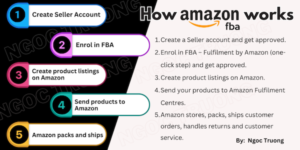
-
Create an Amazon Seller Account and Get Approved: To start selling on Amazon FBA, the first step is to create an Amazon Seller account. This involves providing personal and business information, including tax details and a bank account. Amazon will then need to approve your account, which may include additional verification steps to comply with their seller policies. As long as you prepare documents properly and information on each of your documents match with each other, particularly your name and address, the approval process won’t take long. It used to be more difficult a few years back.
-
Enrol in FBA and Get Approved: Once you have an Amazon Seller account, you can enrol in the Fulfilment by Amazon program with just a click. This enrolment will also go through an approval process to ensure your business meets the FBA requirements, such as the ability to comply with Amazon’s product preparation and shipping requirements.
-
Create Product Listings on Amazon: With FBA enrolment approved, you can start listing your products on Amazon. This involves adding product details, images, and pricing information. High-quality, detailed listings can help your products stand out and can be a significant factor in attracting customers. This is the step where you make it or break it. Because if you don’t have an optimal listing, appealing product presence, you will potentially lose many sales and waste advertising dollars even though you have quality products. This is why I wrote the book “Zero to Bestseller: How to build a 7-figure Amazon listing from day one” to share with you the most effective and proven strategies for building a high-selling product listing right from the start.
-
Send Your Products to Amazon Fulfilment Centres: Once your listings are live, you’ll need to prepare and send your inventory to one of Amazon’s fulfilment centres. Amazon provides detailed guidelines on how to package and ship your products. They will receive and store your products in their warehouses, ready for shipping to customers as soon as orders are placed.
-
Amazon Manages the Rest: When a customer places an order for your product, Amazon takes care of the remaining steps. They will pick the product from the shelves, pack it, and ship it to the customer. Additionally, Amazon handles most aspects of customer service, including processing returns and exchanges. This comprehensive service allows you to focus on other aspects of your business, like sourcing products or scaling up your operation.
By using FBA, sellers can leverage Amazon’s vast logistics network and customer service expertise, which can be particularly beneficial for small to medium-sized businesses looking to expand their reach without significant upfront investment in logistics infrastructure.
How Much Does Amazon FBA Cost?
Selling on Amazon using FBA will incur the following fees:
1. Referral Fee
Referral fee a per-unit commission paid to Amazon for selling your products on their platform, and it varies by product category. Referral fees range from 5% to 45%, with many categories incurring a 15% fee on each unit sold.
This fee is for Amazon to attract customers, maintain, and grow the platform.
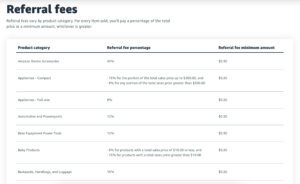
To view the most current Amazon Referral fees for different categories, check Amazon’s Referral fee guide here.
2. FBA Fulfilment Fee
If you opt for Fulfilment by Amazon (FBA) when selling on Amazon, you will pay an FBA fee for each unit sold. This fee is based on the product’s packaging size and weight. It’s different to Referral Fee which is determined by the product category.
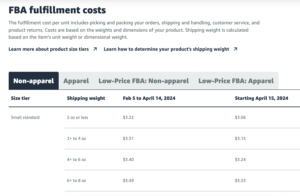
Amazon uses various product size tiers to determine the FBA fee, ranging from Small Standard to Extra-Large. To view Amazon’s most current FBA fees guide, click To view Amazon’s most current FBA fees guide, click here.
If you sell on other channels, such as Etsy or your Shopify store, you can still leverage FBA to fulfill customer orders. In such cases, you will be subject to the Multi-Channel Fulfillment (MCF) fee schedule, which is typically higher than the standard FBA fee. However, it tends to be more economical than most other third-party fulfilment services, thanks to Amazon’s extensive and efficient fulfilment network. For specific MCF rates for your product, check the most recent MCF rate card For specific MCF rates for your product, check the most recent MCF rate card here..
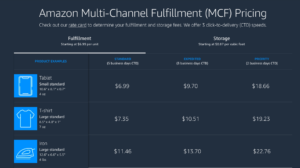
If you use the FBA program for order fulfilment on other channels, without selling products on Amazon, you will be charged the MCF fee but not the Referral fee.
On the other hand, if you sell on Amazon but handle customer orders yourself under the Fulfilment by Merchant (FBM) model, not FBA, you will only pay the Referral fee.
3. Storage Fee
If you use FBA (Fulfilment by Amazon) for customer oder fulfilment —regardless of whether you sell your products on Amazon —you will be subject to a Storage fee. This fee is based on the total cubic meters of your stock at Amazon’s fulfilment centres (FC) and is charged monthly.
4. Subscription Fee
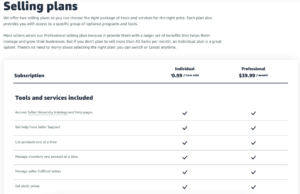
The Professional Selling plan on Amazon costs $39.99 per month. This fee is charged monthly, and you will begin incurring it as soon as you switch to the Professional selling plan. It is a flat fee applicable to sellers of all sizes.
5. Inbound Placement Fee
Starting March 1, 2024, Amazon has introduced a new per-unit Inbound Placement fee applicable when you send products to Amazon’s fulfilment centres (FCs). This fee will be charged regardless of the carriers you use to ship your products to Amazon and is considered a type of ‘receiving’ fee.
However, you may avoid the Inbound Placement fee depending on your shipping method and the quantity of stock you send. For example, you can circumvent this fee by distributing your inventory across multiple Amazon fulfilment centres that Amazon routes for your specific inbound shipment.
Click here to get more insights on Amazon Inbound Placement fee – 2024’s most-talked-about topic.
How Much Does It Cost to Start Selling on Amazon?
Starting a business on Amazon involves several key expenses, which remain consistent across different global markets. Whether you’re setting up in North America, the UK, Germany, or Australia, the costs you’ll encounter include product sourcing, sample costs, account subscriptions, listing creation, and marketing.
- Product Sourcing: Initial stock might cost between $800 and $1,000, depending on the nature and volume of the goods.
- Sample Costs: Expect to spend $70 to $200 on samples to ensure product quality before full-scale purchasing.
- Account Subscription: The monthly fee for a professional selling account on Amazon is $39.99.
- Listing Creation: Creating a compelling product listing can cost between $400 and $500.
- Shipping products to Amazon: Shipping products to Amazon’s fulfillment centers is typically about $300.
- Amazon PPC: Budget around $300 for initial Pay-Per-Click (PPC) advertising to promote your products.
Overall, the estimated launching cost ranges from $1,800 to $2,100. This figure serves as a guideline and may vary based on individual circumstances, scale of operations, and specific market dynamics.
Click here to read my detailed breakdown of the first order when you start selling on Amazon.
